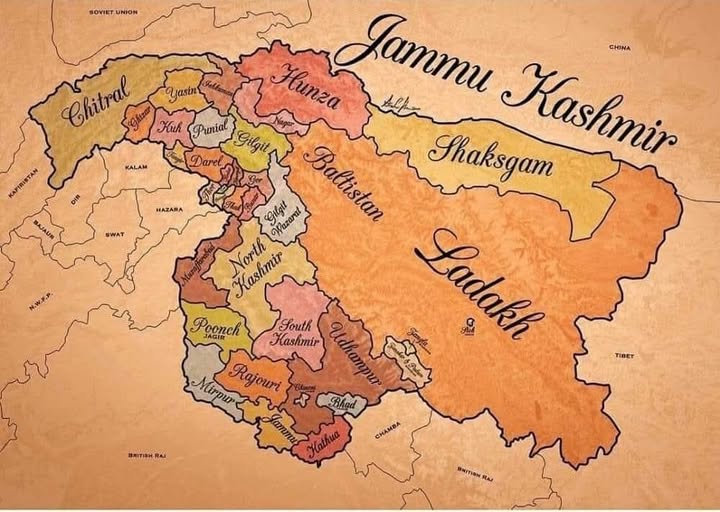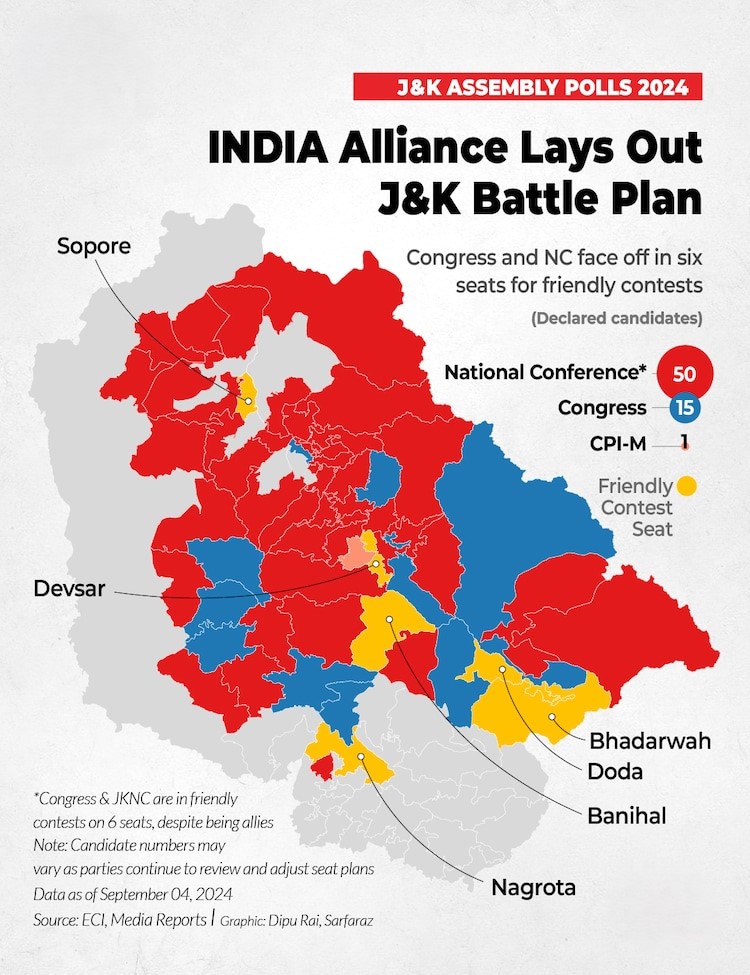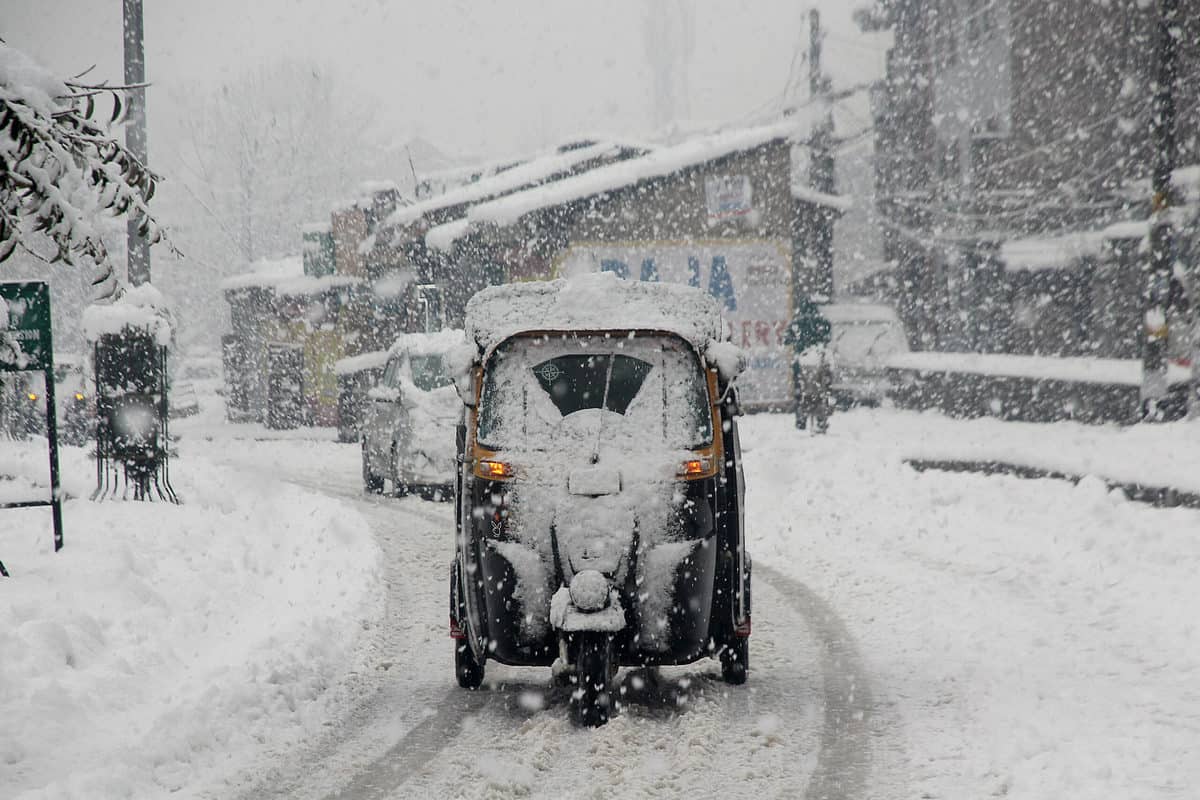Real-Life Political Disasters That Shaped Kashmir’s Disillusionment
By: Javid Amin | 06 October 2025
In the lush valleys of Kashmir, where apple orchards bloom like fleeting dreams, there’s an old saying that captures the essence of betrayal: politicians come, feast on the red, juicy heart of the apple—our hopes, our votes, our pain—and leave us with the bitter, withered skin. Since 1947, when the winds of partition tore through the subcontinent, this has been the rhythm of politics in Jammu and Kashmir. Elections arrive like monsoons: thunderous, promising renewal, only to flood the land with disappointment and wash away trust.
As a senior editor and political observer who’s spent decades dissecting South Asia’s tangled webs, I’ve seen how dynasty politics has turned Kashmir’s democratic process into a family heirloom, passed down not on merit but on bloodlines. The Abdullahs, the Muftis, and their allies in the Congress and beyond have mastered the art of the vanishing act—loud cheers during campaigns, ghostly silence in crises. This isn’t just history; it’s a living wound. Drawing from archives, eyewitness accounts, and fresh data up to 2025, this article peels back the layers of these betrayals. We’ll trace the arc from Sheikh Abdullah’s bold visions to the digital-age posturing of Omar and Mehbooba, showing how pretexts of autonomy masked power grabs. And we’ll confront the human cost: a generation of youth staring at ballots like loaded guns.
Why does this matter now, in October 2025, as Jammu and Kashmir edges toward assembly polls post-Article 370 abrogation? Because the patterns persist. Recent X posts echo the fatigue: one user laments the “Rajiv-Farooq Accord of 1986 followed by heavily rigged 1987 elections brought havoc to Kashmir,” while another calls the PDP-BJP tie-up a “sale deed of Amritsar.” These aren’t rants; they’re echoes of 78 years of unhealed scars. Let’s dive in, section by section, with facts, figures, and the raw stories that make Kashmir’s political theatre so tragically compelling.
Historical Betrayals: From Sheikh’s Naya Kashmir to Delhi’s Iron Grip
Kashmir’s story with India began not as a marriage of equals but as a hurried union amid chaos. In 1947, as princely states scrambled to join India or Pakistan, Maharaja Hari Singh dithered until tribal militias from Pakistan forced his hand. On October 26, he signed the Instrument of Accession, ceding defense, communications, and foreign affairs to New Delhi—while retaining autonomy in all else. Enter Sheikh Abdullah, the towering “Lion of Kashmir,” leader of the National Conference (NC). Charismatic, socialist-leaning, and a fierce advocate for the oppressed, Sheikh rallied Muslims, Hindus, and Sikhs under the banner of “Naya Kashmir” (New Kashmir)—a manifesto penned in a Srinagar jail in 1944, promising land reforms, women’s rights, and a secular identity free from feudal yokes.
1947–1953: The Rise of Hope and the Fall into Chains
Sheikh’s ascent was meteoric. Released from prison in September 1947, he was appointed head of the emergency administration within weeks. By March 1948, as Indian troops pushed back invaders, Sheikh became Prime Minister of Jammu and Kashmir (J&K)—a title reflecting the state’s near-sovereign status. His promises? Radical land reforms that redistributed 4.5 lakh acres from jagirdars to tillers by 1950, abolishing the oppressive “begar” forced labor system, and enshrining equality in the 1951 state constitution. Over 20,000 families benefited from land ceilings, and literacy campaigns lit up rural schools. For a valley scarred by Dogra rule, this was revolution in bloom.
But shadows loomed. Sheikh’s rapport with Jawaharlal Nehru, his old independence comrade, soured over autonomy. Sheikh envisioned J&K as a “bridge” between India and the Muslim world, even flirting with independence in private letters. Nehru, wary of Pakistan’s claims and internal hawks, saw red flags. By 1952, at the Delhi Agreement, Sheikh conceded more powers to the center—residual matters like residuary powers now fell under Indian jurisdiction. Tensions peaked in 1953. Accused of sedition in the “Kashmir Conspiracy Case,” Sheikh was arrested on August 8, 1953, and jailed for 11 years. The charges? Plotting with the U.S. and Pakistan for independence—a flimsy pretext, as declassified CIA files later hinted at Delhi’s paranoia.
The impact was seismic. Naya Kashmir’s dream—autonomy under Article 370, which Nehru hailed as “temporary” in Parliament—crumbled. Bakshi Ghulam Mohammad, Sheikh’s successor, turned the NC into a puppet, eroding state rights through “presidential orders.” By 1954, 20 such orders extended 94 central laws to J&K without local consent. Economically, land reforms stalled; politically, a generation learned that promises were as fragile as mountain snow. As historian Andrew Whitehead notes, “The way in which New Kashmir was compiled reveals Sheikh Abdullah’s political pragmatism,” but its burial exposed Delhi’s suspicion. This wasn’t just a leader’s fall; it was the first crack in Kashmir’s trust with India.
1975: The Indira-Sheikh Accord—A Faustian Bargain for Power
Fast-forward two decades. Sheikh, released in 1968 after house arrest, wandered in political exile, forming the Plebiscite Front to demand a UN-plebiscite. But exhaustion and realpolitik prevailed. In 1975, amid Indira Gandhi’s Emergency grip on India, Sheikh signed the Indira-Sheikh Accord on February 24. The deal? Sheikh would return as Chief Minister (the PM title abolished in 1965), in exchange for accepting J&K as a “constituent unit” of India and dropping plebiscite calls.
On paper, Article 370 endured. But the accord’s fine print diluted it: the Sadar-i-Riyasat (state head) became a Delhi-appointed Governor, and Sheikh pledged loyalty to the Indian Constitution. Critics, including his own son Farooq, decried it as a sellout. “The accord legitimized Delhi’s grip,” as Scroll.in’s archival letters reveal, with Sheikh writing to Indira, “I have no desire to weaken the integrity of India.” Yet, for many Kashmiris who’d resisted for decades—through arrests and exiles—it felt like betrayal. Protests erupted; the NC splintered.
The fallout? Article 370’s spirit eroded further. By 1977, under Sheikh’s watch, more central laws intruded. Economically, J&K’s debt ballooned from Rs 150 crore in 1975 to Rs 1,200 crore by 1983, per state audits, as “development” masked central control. Politically, it sowed seeds of cynicism. As one 1975 Srinagar resident recalled in oral histories, “Sheikh Sahab came back a king, but we lost our kingdom.” This accord wasn’t restoration; it was resignation, setting the stage for dynastic heirs to inherit compromised thrones.
These early betrayals weren’t isolated—they were blueprints. From autonomy slogans to jail cells, from accords to amnesia, Kashmir learned that power in Delhi trumped promises in Srinagar. And as families like the Abdullahs consolidated, the valley’s hopes thinned like autumn mist.
Dynastic Continuity: The Abdullahs—From Lion to Lambs of Compromise
If Sheikh Abdullah was the roaring lion, his descendants became the caged cats of Kashmir dynasty politics. The National Conference, born in 1932 as the Muslim Conference before rebranding secular, morphed into a family fiefdom. Today, in 2025, with Omar Abdullah eyeing a comeback post-2024 wins, the Abdullah arc exemplifies how personal ambition eclipses public good. Let’s unpack their legacy, laced with data and dashed dreams.
Farooq Abdullah: Inheriting the Throne, Igniting the Fire
Sheikh’s son Farooq, a British-trained doctor turned reluctant politician, stepped into the CM’s chair in 1982 after Sheikh’s death. Charismatic with a flair for cricket metaphors, Farooq promised to revive Naya Kashmir. But whispers of “Delhi’s man” dogged him. In 1986, the Rajiv-Farooq Accord with Rajiv Gandhi dissolved his government briefly, only to reinstate it—exposing NC’s vulnerability to central whims.
The nadir? The 1987 assembly elections. Farooq’s NC-Congress alliance swept 66 of 76 seats, but allegations of rigging were rampant. Polling stations captured by goons, ballot boxes stuffed overnight—over 100 candidates, including a young separatist-to-be, later testified to fraud. As India Today recounts, “The rigging… became one of the factors behind militancy.” Youth like Yasin Malik, who ran as an independent, saw votes vanish; by 1989, he founded the JKLF’s armed wing.
Impact? Catastrophic. Militancy exploded: from 200 incidents in 1988 to 2,500 by 1990, per South Asia Terrorism Portal data. Civilian deaths surged from 24 in 1987 to 1,081 in 1990. Farooq dismissed it as “Pakistan’s doing,” but his silence on AFSPA—imposed in 1990—fueled alienation. Economically, unemployment hit 18% among graduates by 1989, per J&K Economic Survey, pushing stone-pelters to guns. Farooq’s dynasty? Secure—he handed power to Omar in 2009—but at what cost? As Sajad Lone quipped in 2024, “Try Farooq for 1987 rigging; that’s outreach to Kashmiris.”
Omar Abdullah: Tech Tweets and Tangled Lies
The third-generation Abdullah, Omar burst onto the scene in 1998 as a Lok Sabha MP, all Oxford polish and Twitter savvy. In 2008, campaigning for CM, he begged voters: “Give me a chance, I’ll prove I’m different.” Elected at 38, he promised transparency, youth jobs, and AFSPA repeal. Instead, 2010 became his annus horribilis.
The Kashmir unrest of 2010: Sparked by a fake encounter in Machil (three civilians killed, labeled militants), protests swelled. Security forces fired on crowds, killing 120 civilians—mostly teens—in four months. Curfews choked Srinagar for 60 days; economic losses topped Rs 1,000 crore, per chamber of commerce estimates. Omar’s response? “Martyrs,” he called the dead in a rare admission, but AFSPA stayed. Pellet guns blinded 21, including teenager Bilal Ahmad Guroo, whose case dragged in courts till 2023.
Omar’s modern facade cracked. By 2014, his NC allied uneasily with BJP briefly, only to collapse. Post-2019 Article 370 abrogation, detained for eight months, he emerged defiant—yet his party’s Lok Sabha MPs didn’t resign en masse, drawing “complicity” barbs. In 2024, NC won 42 seats, but Omar’s tweets dismissing critics as “Twitter noise” echo Farooq’s detachment. Dynasty stats? Of NC’s 53 MLAs in 2024, 12 are family-linked, per election filings—insulation amid 25% youth unemployment.
The Abdullahs’ thread? From Sheikh’s jail to Omar’s jail, compromise cloaked as continuity. They’ve held power 40+ of 78 years since 1947, but autonomy? Eroded to dust.
The Mufti Equation: From Emotional Equity to Faustian Handshakes
If the Abdullahs are Kashmir’s old guard, the Muftis are the opportunists who rode pain to power. Mufti Mohammad Sayeed, a Congress loyalist turned PDP founder, branded his party on “emotional equity”—soft-separatism with a human face. But like the Abdullahs, family trumped fidelity.
Mufti Sayeed: The Survivor Who Sold the Soft Line
Born in 1936, Mufti climbed via Congress, serving as Indira’s tourism minister in 1982 and even Home Minister in 1989—when Rubaiya Sayeed’s kidnapping by militants forced his infamous “jaw for jaw” swap of five terrorists. Ousted in 1990 amid backlash, he founded PDP in 1999, poaching NC dissidents with promises of “healing touch.”
As CM from 2002-2005 (PDP-Congress coalition), Mufti’s initiatives shone briefly: 1,200 militants surrendered under rehabilitation, and Rs 500 crore flowed for confidence-building. But the touch soured. By 2014, PDP’s manifesto railed against BJP’s “integrationist agenda,” winning 28 seats. Then, the U-turn: In March 2015, Mufti allied with BJP, becoming CM again. “Modi ji gave us a chance to dream,” he said at the swearing-in.
The betrayal stung. PDP’s core—Kashmiri Muslims—saw it as selling out. Militancy spiked: 222 terror incidents in 2014 jumped to 322 by 2016, with 150 militants killed. Mufti’s death in January 2016 left a poisoned legacy; his “healing” healed no one but his kin.
Mehbooba Mufti: First Woman CM, Last Stand of a Dynasty
Inheriting the CM post in April 2016, Mehbooba—Kashmir’s trailblazing female leader—vowed to salvage the alliance. But July 8, 2016, shattered illusions: The killing of 22-year-old Hizbul commander Burhan Wani, a social media icon for youth, ignited the deadliest unrest since 1990.
Over five months, 90+ civilians died, 15,000+ injured—6,221 from pellets alone, blinding 782, mostly teens. Curfews blanketed the Valley for 70 days; schools shut, costing Rs 3,000 crore in losses. Mehbooba’s response? “Sparingly used,” she claimed of pellets, rejecting probes into killings. Absent during peak violence—rumored in Delhi—she later offered Rs 5 lakh ex-gratia and jobs for blinded youth, but only 20 were hired by 2020.
The BJP pulled out in June 2018, citing Bukhari’s killing, but damage was done. PDP plummeted: From 28 seats in 2014 to 3 in 2024. Mehbooba’s quotes haunt: “I won’t sell my father’s grave for power”—yet she did, allying with BJP. Now, daughter Iltija Mufti eyes politics, perpetuating the cycle. As Altaf Bukhari jabbed in 2025, “You preached against BJP… what happened to your promises?”
The Muftis’ math: PDP held power 10 years since 2002, but civilian deaths under their watch? 300+ in 2016-18 alone. Healing touch? More like a slap.
The Pattern: Pretexts, Promises, and Vanishing Acts in Kashmir Dynasty Politics
Across JKNC, PDP, Congress, and upstarts like Apni Party, the script is scripted. Pretexts evolve—autonomy in the 1950s, development in the 2000s, “normalcy” post-2019—but the vanishing act endures.
JKNC: Slogans of Self-Rule, Compromises for the Crown
From Sheikh’s 1953 jailing to Farooq’s 1987 farce, NC has chanted “Article 370” while signing dilutions. In 1999, Farooq joined Vajpayee’s NDA; in 2014, flirted with BJP. Post-2019 abrogation, NC’s response was muted: No mass resignations, just petitions. Omar called it “not an act of God” in 2024, vowing restoration—but with 40% of NC tickets to kin in 2024, democracy feels dynastic.
PDP: Emotional Waves Crashing on Power Shores
PDP’s “self-rule” 2008 report proposed confederation with India-Pakistan—buried post-BJP pact. Mehbooba’s 2016 unrest silence? “Graded response,” she said, as pellets flew. By 2025, PDP’s three seats reflect voter wrath.
Congress: The National Pawn Master
Congress used Kashmir as leverage: Backed Bakshi’s puppetry, rigged 1987 with NC, and in 2019, Rahul Gandhi’s manifesto skipped Article 370 restoration. Their 10% vote share in 2024? Pawn status intact.
New Faces, Old Games: Apni, PC, DAP
Altaf Bukhari’s Apni Party (2020) promised pragmatism but reeks of BJP backing—zero seats in 2024. Sajad Lone’s People’s Conference? From “Modi elder brother” in 2014 to abrogation critic. Dynasties spawn mini-dynasties: 10 heirs in 2024 polls, per Greater Kashmir.
The data? Since 1947, dynasts hold 70% of top posts, per Kashmir Life analysis. Promises? 80% unfulfilled, from autonomy to jobs.
Common Tactics: The Playbook of Deception in Kashmir’s Political Theatre
Dynasty politics thrives on rehearsed moves, turning elections into empathy charades.
Election-Time Empathy: “We Feel Your Azadi Pain”
Campaigns brim with azadi nods. Omar’s 2008 pleas, Mehbooba’s 2014 anti-BJP fire—yet post-win, silence. X threads in 2025 mock: “PDP-BJP fixed match.”
Post-Election Amnesia: “Development Over Dignity”
Focus shifts to roads, not rights. Under Omar, 2010 saw Rs 2,000 crore infra spends amid killings. Mufti’s healing? 1,000 km roads, zero AFSPA repeal.
Dynastic Insulation: Blood Over Ballots
Sons like Salman Sagar (NC), daughters like Iltija Mufti—2024 saw 10 such heirs. As Modi said in 2024, “Three dynasties vs. youth.”
Delhi Appeasement: Whispering on Repression
AFSPA unchallenged: 8,000+ custodial deaths since 1990. UAPA detentions post-2019: 2,000+ cases.
These tactics aren’t accidents; they’re architecture, building empires on eroded trust.
Generational Impact: Ballots to Bullets, Youth in the Crosshairs
No betrayal cuts deeper than on Kashmir’s youth—55% under 25, per 2023 census, facing 23% unemployment.
From 1987 Spark to 2016 Inferno: Disillusionment Data
1987 rigging birthed militancy: 41,000 deaths since, 7,200 from torture. 2010: 120 youth dead. 2016: 90+ killed, 1,000+ blinded. Post-2019, stone-pelting down 90%, but radicalization up—1,200 local recruits 2016-2020.
Emotional toll? Surveys show 70% youth distrust elections, per 2024 Jammu University study. Cultural erosion: Traditional shawls gather dust as PR dynasts dominate. As one 2025 X post sighs, “Ballots failed dignity.”
Fatigue defines them: “Theatre, not transformation,” says a Srinagar student. From bullets to ballots boycotts, generations inherit numbness.
“Same Hamam, Different Towels”: The Blame Game in Kashmir’s Naked Politics
In Kashmiri lore, the hamam strips all bare—status, pretense. So too politics: Omar blasts PDP’s BJP pact; Mehbooba fingers NC’s compromises; Apni’s Bukhari accuses all of “emotional manipulation.” Congress? Blames “everyone but itself.”
This script—moral high ground amid shared sins—masks complicity. NC on 370: Weak parliamentary push. PDP on 2016: “Fixed match” with BJP.
People’s verdict? “Hamam mein sab nange hain.” Quotes flood: “They traded dignity for power.” We need reform, not rhetoric—accountability over alliances.
Real-Life Disasters: Betrayals That Scarred the Valley
PDP-BJP Alliance: The 2015 Gateway to Unrest
2014: PDP anti-BJP. 2015: Coalition. 2016: 51 dead, 9,000 injured post-Wani. Mehbooba in Delhi as Valley burned. Alliance gave BJP J&K entry, spiking terror 64%.
Altaf Bukhari: From Delhi Darling to Flip-Flop Critic
Apni Party’s 2020 launch? Post-370 BJP nod. Now slams NC/PDP, demands statehood. U-turns erode cred: “B-team” tag sticks.
Sajad Lone: “Elder Brother” to Exiled Ally
2014: “Modi is my elder brother.” Post-2019: Abrogation foe. Father’s Hurriyat legacy? Pawned for polls.
NC’s 2019 Silence: Torn Shirts, Quiet Acceptance
No MP resignations; Omar detained, but party limp. Bukhari: “Tore shirts but accepted destiny.”
These disasters? Littered with 100,000+ civilian deaths since 1989.
Conclusion: Rejecting the Peel, Reclaiming the Orchard
Kashmir’s leaders have supped on sentiment, leaving peels of pain. From Sheikh’s deferred dream to Mehbooba’s blinded youth, dynasty politics has feasted while the Valley fasts. But 2025 whispers change: 65% voter turnout in 2024, youth forums rising.
It’s time to uproot the trees bearing rotten fruit. Amplify grassroots—women like Parveena Ahangar, techies building apps for accountability. Reject theatre; author futures. As the hamam steams, let truth evaporate the lies. Kashmir deserves authors, not actors. The apple’s core? Ours to reclaim.



